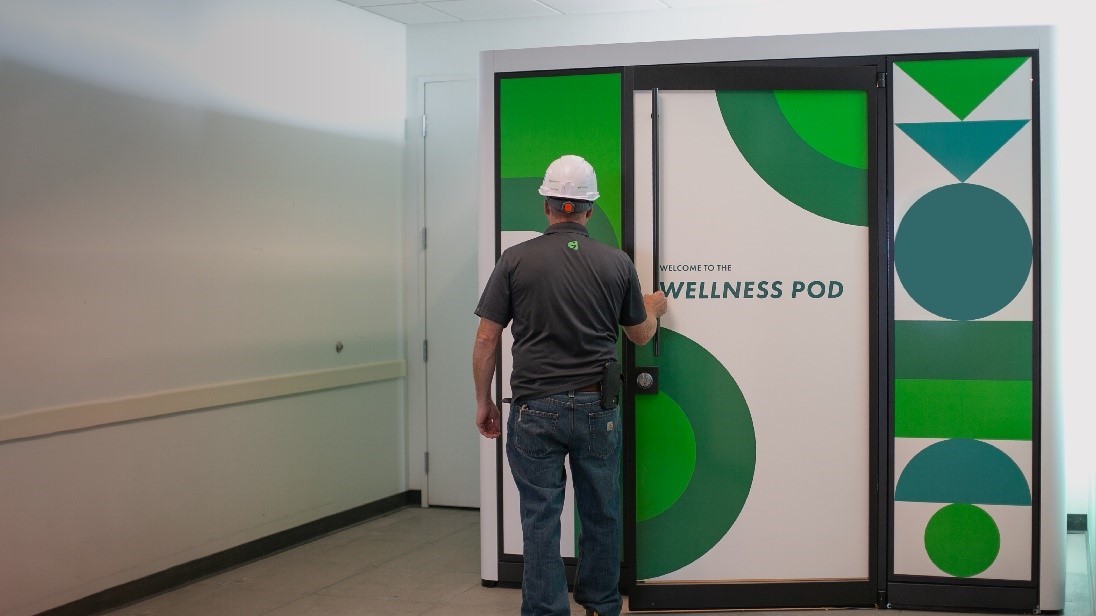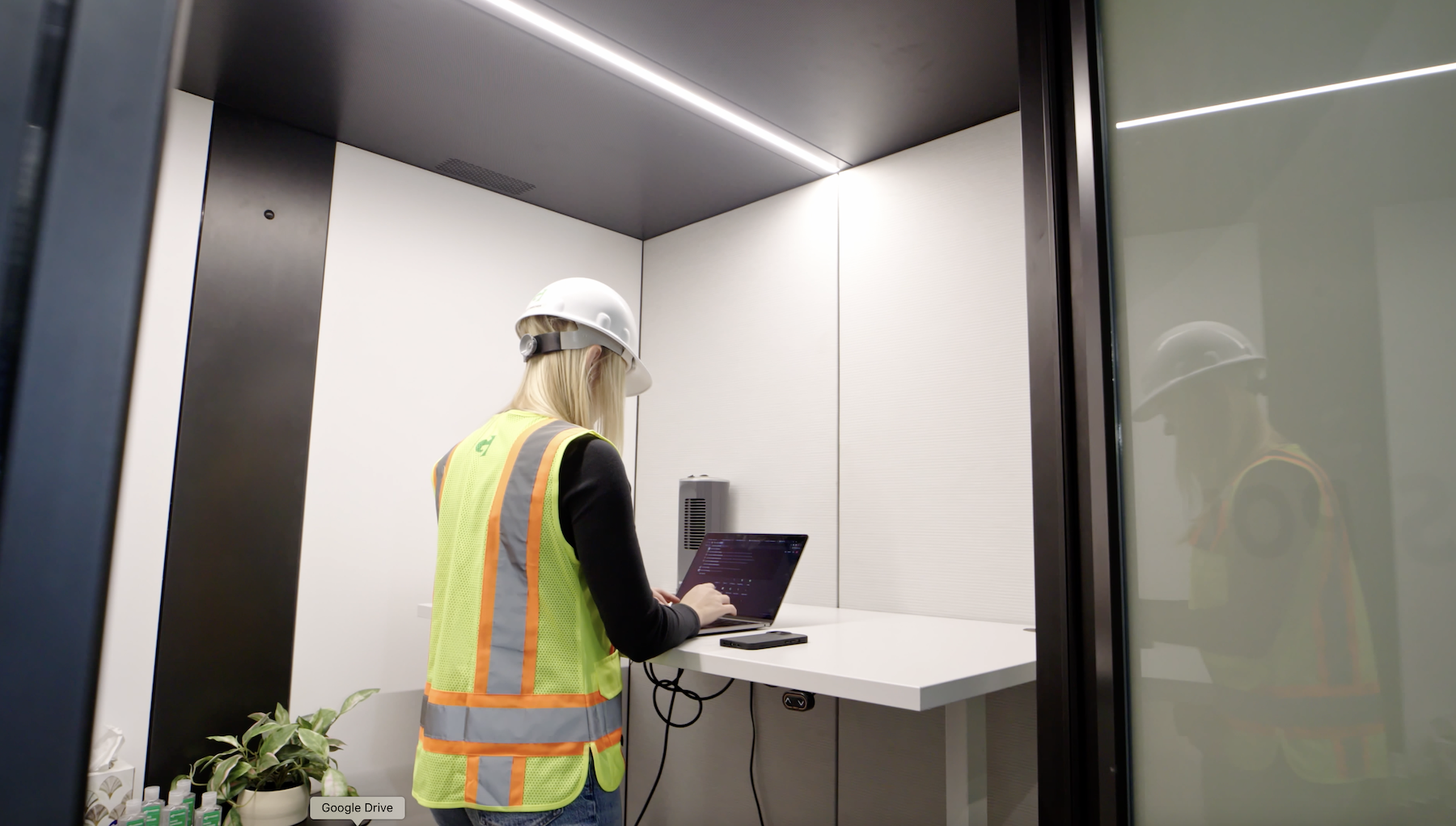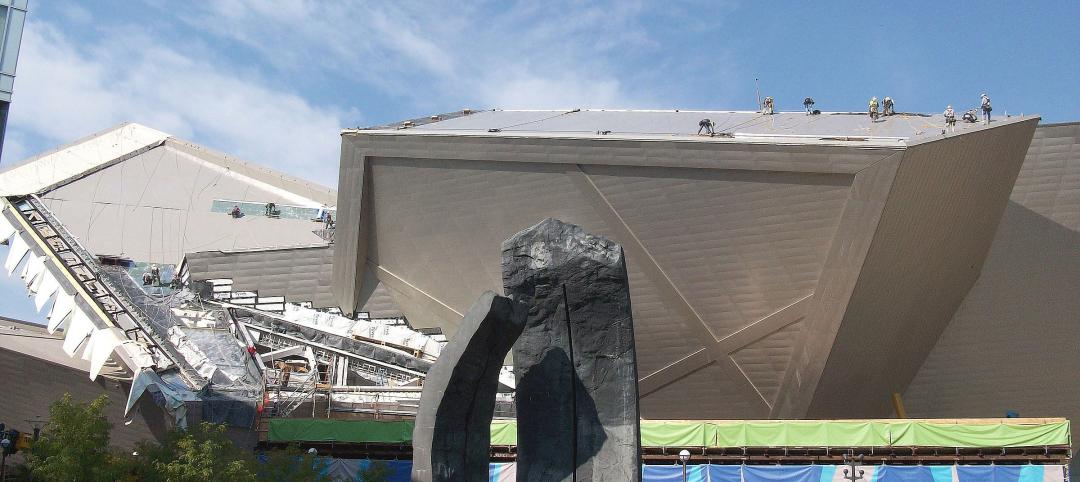The mental health of workers has emerged as an urgent topic within the construction industry, with firms considering the issue as part of their employee wellness initiatives.
One such firm is Minneapolis-based general contractor Gardner Builders. Three of its jobsites currently include Wellness Pods, 6x8-ft steel boxes that provide workers with a temporary, anxiety free sanctuary for private activities. The heated and cooled pods are wheelchair-accessible, with a mini fridge, desk and chair, and rug.
The concept for the pods dates back to last year, when Gardner Builders noticed that its employees engaged in activities that might be best served by having a private space to retire to. This need was expressed further during a meeting of the company’s internal Pulse group, which discusses employee concerns. A 20-year-old female laborer pointed out that she had nowhere to go while at work to pump breastmilk. “The idea for the wellness pod was borne from this,” says Jessica Stoe, Gardner Builders’ Brand, Wellness, and Marketing Director, and Wellness Pod Lead.
The first pods, built in May 2022, were small plywood boxes within Gardner’s offices. Stoe says the goal, then and now, was to create a place that is soundproof, comfortable, and accessible for everything from meditation, telehealth, privacy, and prayer. Based on worker feedback, most employees seem to be using the pods for private calls.
Future pods will be mobile

The pod is more of a concept than a static structure; some are on wheels, for example. Gardner has also partnered with the furniture supplier Teknion to develop its steel pod with a glass door. Stoe estimates that a plywood pod costs Gardner $3,000; the steel model runs between $12,000 and $16,000.
Right now, a jobsite’s foreman or superintendent handles the scheduling for using jobsite pods. Stoe says Gardner is looking into scheduling software similar to what office workers use to book meeting rooms.
Future iterations of the pods, says Stoe, are likely to be more mobile so they can be moved around a jobsite as needed. And Gardner is developing a ground-up, climate-controlled model for exterior use. That model, says Stoe, would have an iPad mounted to it that allows workers to schedule the pod themselves.
Gardner Builders has gotten inquiries about its Wellness Pods from the local YMCA and Chamber of Commerce, and wants to share the concept with other contracting firms.
Related Stories
| Mar 11, 2011
Chicago office building will serve tenants and historic church
The Alter Group is partnering with White Oak Realty Partners to develop a 490,000-sf high-performance office building in Chicago’s West Loop. The tower will be located on land owned by Old St. Patrick’s Church (a neighborhood landmark that survived the Chicago Fire of 1871) that’s currently being used as a parking lot.
| Mar 11, 2011
Community sports center in Nashville features NCAA-grade training facility
A multisport community facility in Nashville featuring a training facility that will meet NCAA Division I standards is being constructed by St. Louis-based Clayco and Chicago-based Pinnacle.
| Mar 11, 2011
Slam dunk for the University of Nebraska’s basketball arena
The University of Nebraska men’s and women’s basketball programs will have a new home beginning in 2013. Designed by the DLR Group, the $344 million West Haymarket Civic Arena in Lincoln, Neb., will have 16,000 seats, suites, club amenities, loge, dedicated locker rooms, training rooms, and support space for game operations.
| Mar 10, 2011
How AEC Professionals Are Using Social Media
You like LinkedIn. You’re not too sure about blogs. For many AEC professionals, it’s still wait-and-see when it comes to social media.
| Mar 7, 2011
Sika Sarnafil announces 2010 roofing Contractor Project of the Year winners
Sika Sarnafil announced winners of its 2010 Contractor Project of the Year Competition. Twelve contractors were recognized for outstanding workmanship in completing a project using a Sika Sarnafil thermoplastic membrane for roofing or waterproofing applications. A winner and two finalists were chosen from each of four different categories: Low Slope, Steep Slope, Waterproofing and Sustainability.
| Mar 3, 2011
Webcor Builders and Shangri-La Construction form partnership
Webcor Builders and Shangri-La Construction announced today that the two general contractors have formed an exclusive partnership to pursue and provide general contracting and construction management services in select western states including California, Arizona, Nevada and Texas. The partnership, which will be named Webcor LA, will pursue construction projects across aviation, commercial real estate and tenant improvement, hospitality, institutional, healthcare, industrial, public works, and multi-family categories.
| Mar 2, 2011
Design professionals grow leery of green promises
Legal claims over sustainability promises vs. performance of certified green buildings are beginning to mount—and so are warnings to A/E/P and environmental consulting firms, according to a ZweigWhite report.
| Mar 2, 2011
How skyscrapers can save the city
Besides making cities more affordable and architecturally interesting, tall buildings are greener than sprawl, and they foster social capital and creativity. Yet some urban planners and preservationists seem to have a misplaced fear of heights that yields damaging restrictions on how tall a building can be. From New York to Paris to Mumbai, there’s a powerful case for building up, not out.
| Mar 1, 2011
How to make rentals more attractive as the American dream evolves, adapts
Roger K. Lewis, architect and professor emeritus of architecture at the University of Maryland, writes in the Washington Post about the rising market demand for rental housing and how Building Teams can make these properties a desirable choice for consumer, not just an economically prudent and necessary one.
| Feb 24, 2011
Lending revives stalled projects
An influx of fresh capital into U.S. commercial real estate is bringing some long-stalled development projects back to life and launching new construction of apartments, office buildings and shopping centers, according to a Wall Street Journal article.












